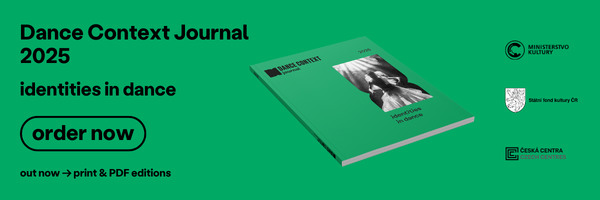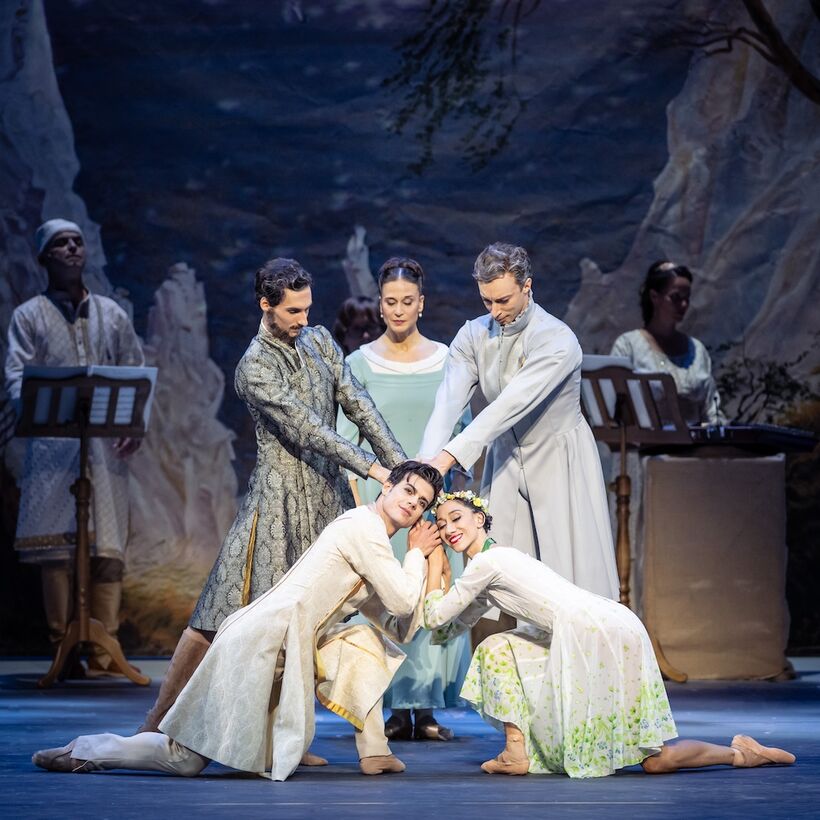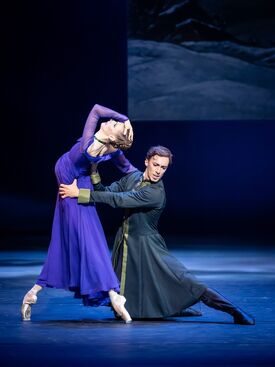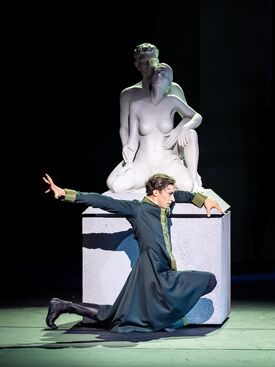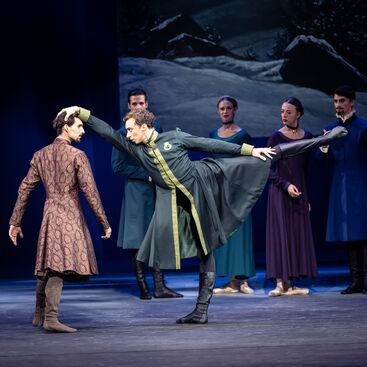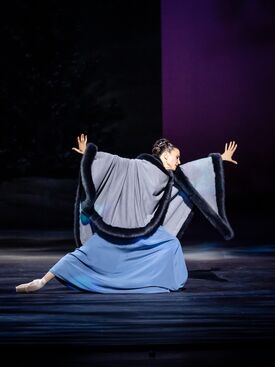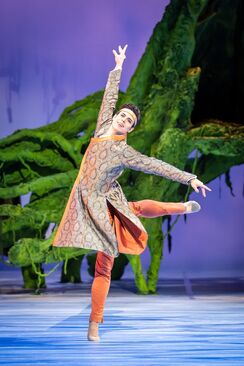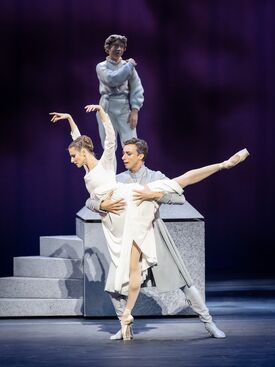His success begins with his choice of material. He doesn’t go for the obvious classics, yet still finds popular themes and characters that work very well on the dance stage. With Like Water for Chocolate, he was even ahead of the times in 2022: Laura Esquivel’s novel, which the ballet is based on, was turned into a hit TV series this year. And just a couple of weeks ago, Wheeldon premiered his boldest work to date: Oscar©, created for the Australian Ballet, exploring the life and work of Oscar Wilde, focusing on oft-neglected queer aspects. But the most significant “secret” of Wheeldon’s success lies in his clever use of dramaturgy. With only a couple of twists on the original material, he makes even the grandest and most complicated stories easy to follow, without ever becoming banal or didactic, which is often the case with nineteenth-century ballet classics.
The Winter’s Tale – Christopher Wheeldon’s Shakespearean Adventure Arrives in Vienna
The Vienna State Opera ballet company recently presented his 2014 take on Shakespeare’s later work The Winter’s Tale, which apparently has never been choreographed before Wheeldon’s version.
Although British-born Wheeldon has worked for Broadway and fashion shows, created one-act ballets, and reworked several classics, it is his success in developing brand-new, full-length story ballets that has had the biggest impact on the dance world. To see just how rare that talent is, we only need mention that his biggest hit to date, Alice’s Adventures in Wonderland was the first commissioned full-length ballet at the Royal Ballet for more than twenty years at the time of its premiere in 2011. Until that point, London’s ballet company had relied – and, in fact, still does – mostly on nineteenth-century classics and the work of two of their legendary choreographers: Frederick Ashton and Kenneth MacMillan. The situation is similar everywhere: Most companies are lucky if they produce one genuinely significant, world-renowned classical choreographer every few decades. No wonder that Wheeldon’s Alice has already been staged by several ballet companies from Stockholm to Tokyo, and his other pieces are starting to follow suit. Put it this way: if you like ballet, it’s good to live in the era of Christopher Wheeldon.
The Winter’s Tale’s world premiere was by the Royal Ballet in 2014, the 450th anniversary of Shakespeare’s birth. It was the first ballet adaptation of one of The Bard’s works since MacMillan’s Romeo and Juliet in 1965. The Winter’s Tale is one of Shakespeare’s last works, often labelled “complicated” and “messy”, but once again, it is rendered clear and enjoyable in Wheeldon’s hands. Leontes, King of Sicilia and Polixenes, King of Bohemia, have been friends since childhood. But when Polixenes comes to visit Leontes and makes friends with his wife, Hermione, Leontes accuses them of adultery and believes Polixenes to be the father of Hermione’s unborn child. In a fit of jealousy, he chases away Polixenes and puts Hermione in prison. When, in his increasing madness, he rejects his wife’s newborn daughter, both Hermione and her son, Mamillius die of heartbreak. Baby Perdita is brought to the shores of Bohemia, where a shepherd and his son find her. In the second act, we see sixteen-year-old Perdita with her lover, Florizel, who is Polixenes’ son disguised as a shepherd. When the King finds out about the romance, he is not happy at all, so the lovers run away to Sicilia and ask Leontes for help. The remorseful King gives them his blessing, realising only later that Perdita is, in fact, his long-lost daughter. In a final, happier turn of events, it is revealed that Hermione has been alive all along, hidden by her housekeeper Paulina. Leontes’ family is reunited.
For the Vienna State Opera’s ballet company, it is their second encounter with Wheeldon’s work after staging the one-act piece Fool’s Paradise in 2015, and their production does not disappoint. The first act is packed with high drama, and Olga Esina and Marcos Menha’s acting perhaps requires a little more power and edge (in the roles of Hermione and Leontes), but then again, dancing with a fake pregnancy bump and partnering a ballerina with one must require tremendous concentration. The second act is the highlight of the piece in every respect. The joyful Spring celebration evokes the village scenes of classics such as Giselle and La Fille mal gardée, giving great opportunity but also great responsibility to the corps de ballet. Vienna’s corps is precise, but also airy and witty throughout. But it is Ioanna Avraam in the role of Perdita who really lights up the stage in this act. Apart from her lightness and technical excellence, she brings so much charm to the role that it is impossible not to love her. Her Florizel, Davide Dato, is a steady and likeable partner, though a little restrained on this particular evening – with a little more effort, he could have stolen the limelight a little more. Esina and Menha (no pregnant belly anymore) also come across better in the last act: Their final pas de deux does justice to the lyricism of the scene.
Wheeldon’s choreography is nuanced and sweeping, not least thanks to his longtime collaborator, composer Joby Talbot, with whom he always develops the scenario. Wheeldon never tries to divert attention with great stunts or self-indulgent athleticism; in his ballets, movement is always in the service of story and character. The clever and creative ideas in dramaturgy and scenery make his work stand out. In The Winter’s Tale, one of my favourite details is when, in Act I a, simple change of light during a duet shows us what is real and what is only happening in Leontes’s jealous mind. And the simple, understated final scene that pays tribute to the ultimate victim of the story, Mamillius, is a great example of the choreographer’s elegance.
Every company that has one of Wheeldon’s story ballets in their repertoire can count themselves lucky, not only because of the many and versatile soloist roles they provide, but also because he excels at capturing the audience’s hearts. The Winter’s Tale in Vienna showed once again that classical ballet is not merely a thing of the past: it very much has its place in the present and future.
Written from the performance of 29 November 2024 at the Vienna State Opera
The Winter’s Tale
Music Director: Christoph Koncz
Music: Joby Talbot
Choreography: Christopher Wheeldon
Scenario: Christopher Wheeldon, Joby Talbot
Designer: Bob Crowley
Lighting Designer: Natasha Katz
Projection Design: Daniel Brodie
Silk Effects Design: Basil Twist
Staging: Jason Fowler, Gregory Mislin, Jillian Vanstone, Edward Watson
Leontes, King of Sicilia: Marcos Menha
Hermione, Queen of Sicilia: Olga Esina
Perdita, Princess of Sicilia: Ioanna Avraam
Mamillius, Prince of Sicilia: Davide Culmone
Paulina, Head of Queen Hermione’s Household: Claudine Schoch
Antigonus: Igor Milos
Polixenes, King of Bohemia: Arne Vandervelde
Florizel, Prince of Bohemia: Davide Dato
Steward: Duccio Tariello
Father Shepherd: Eno Peci
Brother Clown: Kristián Pokorný
Young Shepherdess: Gaia Fredianelli


